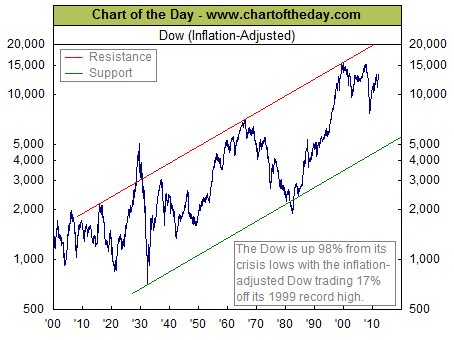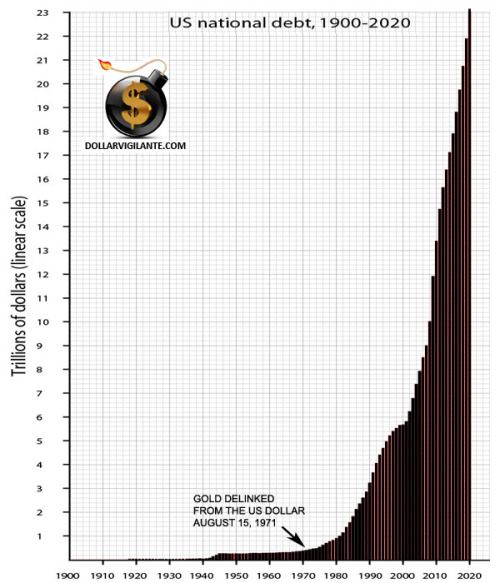Why pensions are going broke
April 13, 2012
By John Seiler
Why are government pensions going broke? Wayne Lusvardi wrote about recently it in one of our Special Series on municipal bankruptcy, “California counties are more at risk of going belly up.”
In one sentence, he wrote, “No one knows what rates of return pension funds will yield in the future”
In a reply, “Truthsquad” referred to that sentence, and commented,
“Exactly — but we can look at the past and lifetime of the pension systems in our state. Historically the returns have been well over 8 percent. Framing the picture to say returns will be as low as they are during an economic downturn is bogus, and thus undermines the ‘sky is falling premise of the information provided here.”
But look at the following chart.
It shows the performance of the Dow Jones Industrial Average since 1900, but adjusted for inflation. Pension funds generally mirror the stock market.
Look on the right side. The DJIA has shown essentially no growth for about 13 years, since the dot-com bust of 1999-2000. There was “growth” in the mid-2000s, but it was fake growth from the real estate boom — which quickly became the real estate bust.
This dismal record occurred under both Republican President George W. Bush and Democratic President Barack Obama, as well as under Congress when it was controlled, alternately, by Democrats or Republicans. So there’s plenty of blame to go around. And today’s “gridlock” — the Dems controlling the White House and the U.S. Senate, and Reps controlling the U.S. House — isn’t any better, either.
The assumption by “TruthSquad” and other defenders of the existing pension system is that growth will resume, zoom upward, and make up for the recent stagnation. But how can it make up for 13 years of stagnation?
Basically, you would need another Ronald Reagan to come in and cut taxes and regulations. Check out the chart: After he did that in 1981, growth rose sharply and lasted two decades. Bill Clinton, contrary to popular belief, did not revoke Reagan’s policies, but continued them. Clinton did increase taxes once; but he also cut taxes twice. So it basically was a wash — that is, a continuation of Reagan’s policies.
The Bush “tax cuts” of 2003 were temporary, leading to the ongoing extension crises. That means nobody knows what next year’s tax levels will be, thus scrambling business and personal tax and spending calculations. The economy only will grow when taxes are stabilized — with no new taxes; and when the Federal Reserve Board ends its inflationary, low-interest policies.
Moreover, “TruthSquad” doesn’t point out that even CalPERS doesn’t hold to that 8 percent figure. It recently cut its retrun expectations rate from 7.75 percent to 7.5 percent.
And CalPERS itself pays only 3.8 percent for “terminated pension plans” — those seeking to get out of its system. That’s the real amount that ought to be used in its own calculations.
Federal debt rising
Meanwhile, the U.S. government’s debt is $16 trillion and rising. And that doesn’t even include the debt for federal civilian and military pensions, Medicare, Medicaid and Social Security.
Look at this chart from an article on LewRockwell.com:
There’s nothing but economic disaster that can come from such a heavy load of debt. The fedeeral government will have to continue its recent policies of inflating the currency, meaning more economic stagnation.
Imposing President Obama’s “Buffett tax” won’t help. Assuming it works, it would raise at most $160 billion over 10 years, or $16 billion a year, according to the liberal Center for American Progress. But the budget deficit is more than $1 trillion a year. With interest on the $16 trillion debt also compounding, that $16 billion (note the “b) a year is like spitting in the Pacific Ocean.
Another ‘lost decade’
“TruthSquad” expects economic growth to pick up substantially because it has in the past. But why should it? Japan already is in its third “lost decade.” America has had one “lost decade,” 1999 to 2009; and now is well into its second, 2010-2012. American economic polices, as outlined above, are as dismal as ever.
Unless you believe Mitt Romney is the reincarnation of the Gipper (I don’t), then there’s nothing but more doom and gloom.
The pension funds will cut more deeply into state and local budgets.
If you disagree with me, then there’s something simple to do: Work to end the taxpayer guarantee for pension payments to retirees. Currently, state and local taxpayers are on the hook for shortfalls in pension performance.
Well, if these pension funds are expected to rise by an average of 8 percent per year, then there’s no problem; there’s no need for a taxpayer guarantee.
Memo to “TruthSquad”: As we say in America, Put your money where you mouth is.
Related Articles
Snake Oil Legislators
APRIL 21, 2010 Nearly every person I talk to is either feeling the crush of the bad economy or knows
Pensions push state to insolvency
FEB. 23, 2010 By TROY ANDERSON As the $17 billion annual taxpayer tab for government employees’ pensions and retiree health care increases
Business-friendly bill or not?
Jan. 11, 2010 By KATY GRIMES In what appeared to be the first good news of the new year, the




